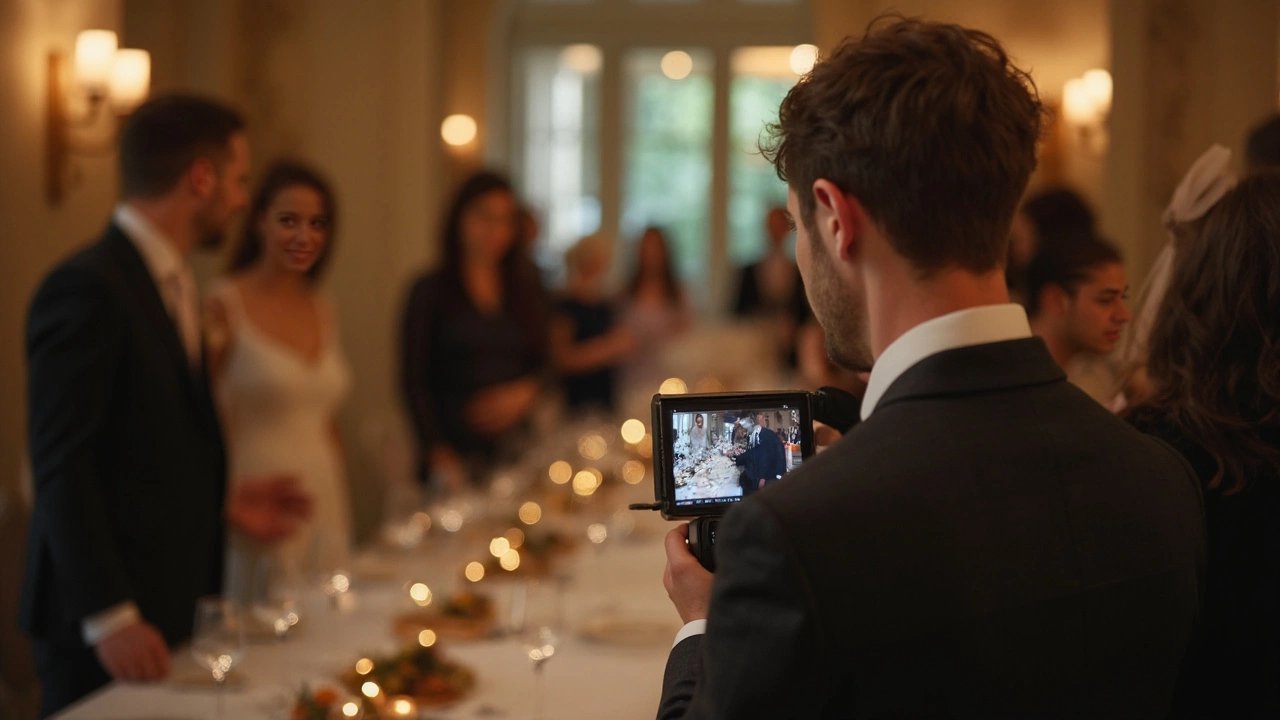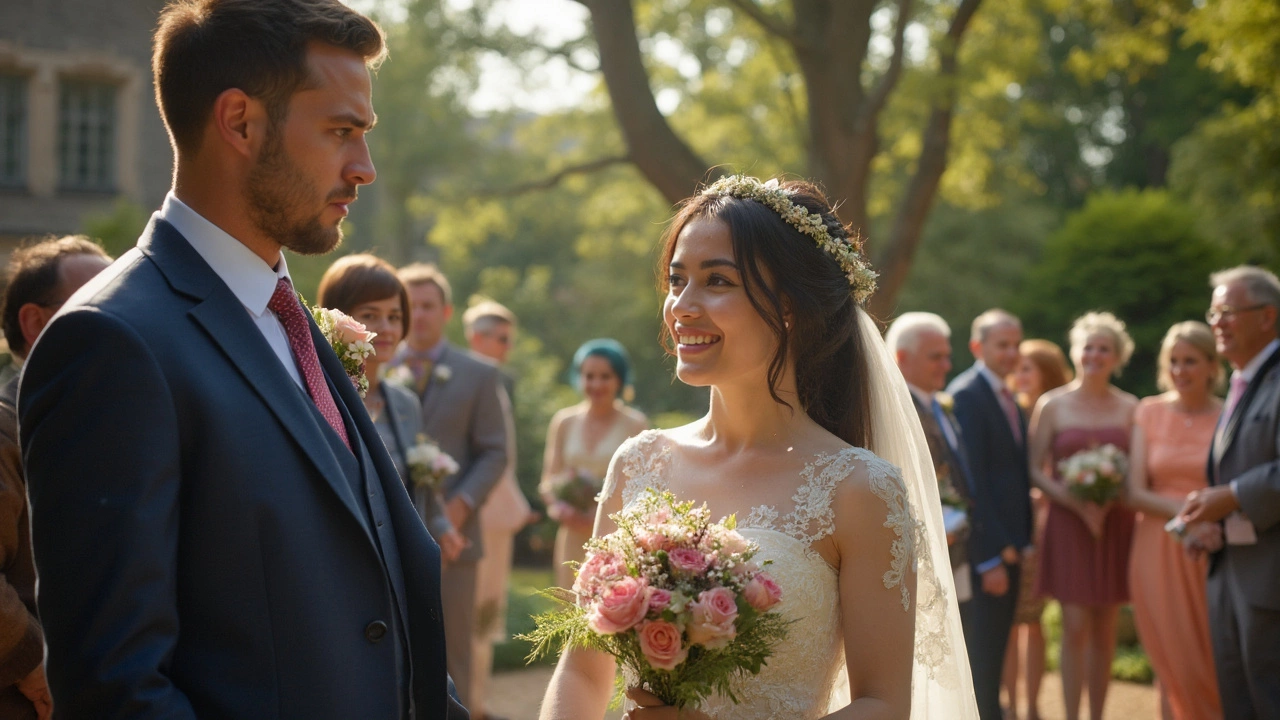One of the most common questions couples ask: how long does a wedding photographer need to stick around? There’s no magic number—it all depends on what you want covered, your timeline, and your budget.
Most photographers offer packages ranging from four up to twelve hours. Some even toss in unlimited coverage, but that’s not always what you need. Think about what matters most—do you want “getting ready” pictures, or just care about the ceremony and party? The more events you add to your must-have list, the longer your photographer needs to be there.
Here’s something a lot of couples don’t realize: there’s usually a lull or two during weddings where nothing really photogenic is happening. Smart planning means you don’t wind up paying for hours of coverage during dinner or down-time—unless you’re into posed group shots and candids at every turn.
- What Does Full-Day Wedding Photography Really Mean?
- Typical Photography Coverage: How Many Hours Do You Need?
- Key Moments Photographers Should Capture
- Tips to Maximize Your Photography Hours
- Questions to Ask Your Photographer About Timing
What Does Full-Day Wedding Photography Really Mean?
When you hear a wedding photographer talk about “full-day coverage,” you might picture someone snapping away from sunrise until everyone’s headed home at midnight. In reality, it’s not quite that long. Most wedding photography packages that say “full-day” usually cover between 8 and 10 hours, not a literal dawn-to-dusk deal.
This block of time usually starts while you’re getting ready—think hair, makeup, and putting on the dress or suit—and runs through to the dance floor moments in the evening. Rarely does full-day actually mean absolutely every minute of your day is photographed. When in doubt, always ask your photographer what their version of “full-day” really includes.
Here’s a quick peek at what’s commonly covered:
- Prep shots (both partners, if locations allow)
- Details: rings, dress, suit, flowers, décor, and venues before guests arrive
- First look (if you’re doing one)
- Ceremony from start to finish
- Family, wedding party, and couple portraits
- Reception highlights: first dances, toasts, cake cutting, candids on the dance floor
If you want your send-off or a late-night fireworks moment, you might need to add a couple more hours or talk about a custom timeline.
Want to see the breakdown? Here’s an actual look at how the hours often add up:
| Event | Estimated Time Needed |
|---|---|
| Getting Ready | 1-2 hours |
| Ceremony | 30-60 minutes |
| Portraits & Family Photos | 1-2 hours |
| Reception Events (first dance, toasts, cake, open dance) | 4-5 hours |
So if you’re booking an “8-hour” full-day package, odds are you’ll get everything above except maybe the very end of the party. If you care about those last wild dance shots, you’ll want extra time or even a second shooter.
Typical Photography Coverage: How Many Hours Do You Need?
Let’s get real about wedding photography hours. There’s no one-size-fits-all answer, but some clear patterns have popped up over the years. According to a 2024 survey by WeddingWire, about 60% of couples book their wedding photographer for 8 hours. This is enough to catch most big moments, from getting ready through part of the reception, without breaking the bank.
If you’re having a small wedding or skipping any traditions, you might only need 4-6 hours. That usually covers the ceremony, family photos, couple portraits, and a slice of the party. On the flip side, if you want everything—hair and makeup to the last song—think 10-12 hours (or even more for cultural weddings with long ceremonies).
| Hours Booked | Typical Coverage Includes | Who Chooses This? |
|---|---|---|
| 4-6 Hours | Ceremony, basic portraits, part of reception | Smaller weddings, weekday events, tight schedules |
| 8 Hours | Getting ready, ceremony, portraits, much of the reception | Most couples; traditional full-day weddings |
| 10-12+ Hours | Full prep, first look, full ceremony, major events, party, exit | Multi-location, longer or cultural weddings, full coverage |
Here’s a quick tip: Don’t just pick more hours by default. List out the parts of your day you care about most, then chat with your photographer to line up coverage just for those. Some pros offer a la carte or hourly options now, so nobody’s stuck with generic packages. If you’re squeezing your budget, try shifting traditions (like cake early in the night) so you get those shots before the photographer heads out.
Still lost? Ask for example timelines from photographers. They’ll often show how coverage lines up with the key events and help you spot any boring lulls you can skip.

Key Moments Photographers Should Capture
If you're hiring a wedding photographer, you want to make sure they're there for the big stuff—not just snapping random pics all day. Some moments matter way more than others for your album and your memories. Here’s a breakdown of what pros usually focus on and why these shots become the ones you’ll keep forever.
- Getting Ready: These photos set the tone. Picture the dress, shoes, and those nervous laughs with friends. If seeing each other before the ceremony matters (the “first look”), this is the time.
- Ceremony: The main event. Key shots include walking down the aisle, exchanging vows, the first kiss, and signing the marriage certificate. These are always must-haves.
- Family and Group Photos: Don’t skip these – even if wrangling relatives is chaos. Pro tip: Make a list ahead of time so the photographer catches everyone important.
- Couple Portraits: The golden hour after the ceremony is when most photographers get creative. Lighting is usually the best, and couples look happiest right after saying “I do.”
- Reception Highlights: First dance, cutting the cake, emotional speeches, and of course, some wild dance floor moments. If you want sparkler exits or a night shot, let your photographer know too.
Here’s a quick glance at the moments couples most often want covered, based on a survey from WeddingWire in 2024 (covering over 2,000 couples):
| Wedding Event | % of Couples Who Want Photos |
|---|---|
| Getting Ready | 87% |
| Ceremony | 100% |
| Group Portraits | 93% |
| Reception Highlights | 96% |
| Send-off/Exit | 72% |
You can see: the ceremony, group shots, and reception stuff top the list. When picking your package, use this as a checklist for what hours actually count. Ask your photographer about timing for these moments – nobody wants to miss the confetti cannon or grandma’s dance moves because the contract ended too soon.
Tips to Maximize Your Photography Hours
If you want to get the most from your wedding photography coverage, you’ve got to be smart with your timeline. A few tweaks here and there will make sure no minute is wasted, plus you’ll end up with more meaningful photos and fewer gaps in your album.
- Batch your events together. Try to do the first look, family portraits, and wedding party shots one after the other before the ceremony. This knocks out a ton of posed photos, and frees up more time later for you to actually enjoy the day.
- Have a shot list ready. Give your photographer a clear list of must-have groupings or candid moments. This keeps things moving and makes it way less likely anything important is missed.
- Schedule buffer time. Build a 15-20 minute buffer into the timeline for unexpected delays—yes, even organized weddings run late. This avoids the photographer running out of time right before cake cutting or speeches.
- Limit idle time. If there’s a long downtime, like during dinner or a break between events, consider having your photographer take a short break or even leave during these lulls. Most guests aren’t looking their best mid-bite!
- Do the grand exit earlier. If you want a fun send-off photo but your party will go late, fake the exit with just your wedding party and close family. This way, your photographer captures the magic before clocking out.
Most importantly, communicate your priorities early. The more your photographer knows about what you really care about, the easier it is to fit coverage where it really matters. Don’t be shy about asking for a custom package—most pros are happy to build something that fits your exact timeline and budget.

Questions to Ask Your Photographer About Timing
Getting clear on timing with your wedding photographer before the big day can save you from stress, awkward pauses, and unexpected fees. If you’re not sure what to ask, start with the basics—these conversations make a real difference in how your wedding is shot and how much you end up paying.
- What’s included in your package hours? Some packages count travel time, breaks, or even setup as part of your coverage. Get specifics on when the clock starts and stops.
- Do you work with an assistant or second shooter? With two shooters, you might capture more events in less total time, which can help if your timeline is tight.
- Are there extra charges for going over the booked hours? Photographers often bill by the hour after your time’s up, and overage rates can be as high as $300 per hour. Ask up front so you don’t get blindsided.
- How do you plan the shooting timeline? Good photographers walk you through what’s realistic for family shots, couple portraits, and those in-between candid moments. Ask them for sample timelines—they’ll often have a go-to plan ready for you.
- What’s the best time for certain photos? Golden hour portraits look better than harsh midday shots. Your photographer can recommend when to schedule key moments for the best light.
- Are you familiar with our venue? Someone who knows your spot can work quicker and suggest ideal times and places for those essential photos.
If you want to get even more concrete, here’s a table showing typical coverage times booked by couples in the U.S. (2024 data):
| Package | Hours | Percentage of Couples |
|---|---|---|
| Half-Day | 4-6 | 18% |
| Standard | 7-8 | 52% |
| Full-Day | 9-12 | 25% |
| Unlimited | 12+ | 5% |
Don’t be shy about sharing your timeline and specific worries. Photographers have seen it all—and the best ones will help you stretch your coverage to work for your priorities and budget. Remember, clear communication now means fewer surprises on your wedding day.
